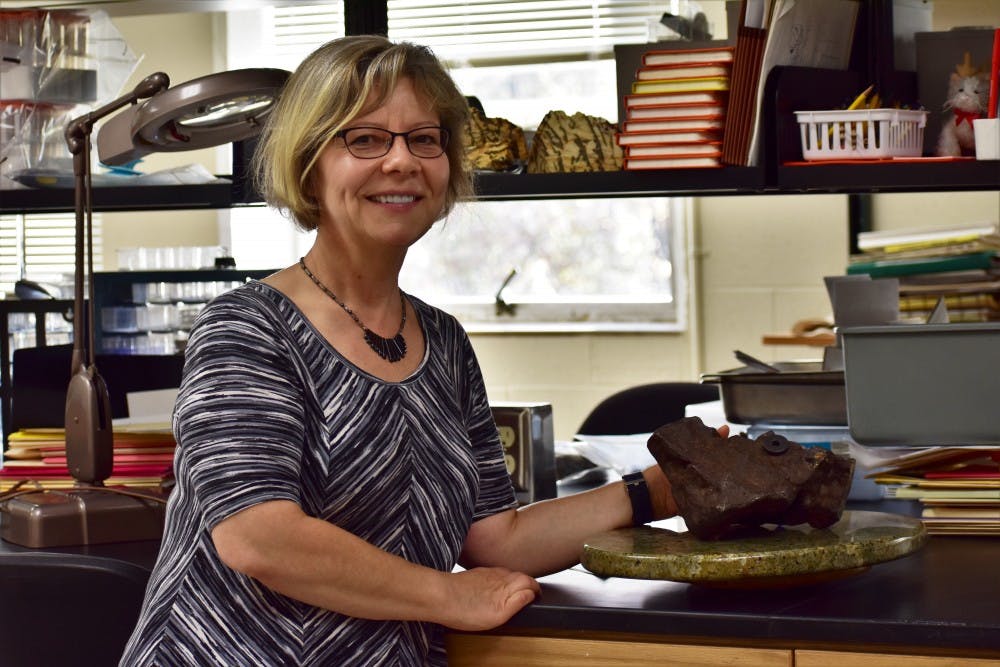Q&A: Geology professor discusses viral meteorite discovery
Mona Sirbescu found a true meteorite specimen which was used as a doorstop for decades
Following the publication of her meteorite discovery, Earth and atmospheric sciences faculty member Mona Sirbescu is still reeling from the impact the story created.
News outlets and strangers who believe they have a meteorite on their hands bombard her work email nearly every day. Luckily, she had enough time to sit with Central Michigan Life and catch up on the aftermath.
What drew you to geology?
Initially I was born and raised in a small village in Romania, and this is an area where I was surrounded by nature. They took us on a field trip to see gold mines, copper and museums in Romania which is a beautiful country with a lot of geology.
My two older brothers knew a little more about Earth science, and this prompted me to look around and study fossils, rocks and coal. When it was time for me to select something, I was between archaeology and geology. In the end, geology won.
Do you consider yourself a meteorite expert?
By no means am I a meteorite expert. I’m an expert on terrestrial rocks. Therefore, when people bring to me their weird specimens, I take a look, and then I use all my experience with Earth materials to figure out whether it’s something that I recognize or something out of this planet.
Did you immediately notice something different about this specimen?
In this case, my gut feeling told me within seconds that it was something different. At first, I felt it was really was something unusual, but my scientific experience basically put me on the path of methodical tests. I needed to take every test possible, so I would not make a mistake. In other words, I almost instantly said, 'no this cannot be. This is just a hypothesis.'
In this case, what was very unusual was the fact that it was covered in these weathering patterns that reminded me of Widmanstätten patterns. This pattern are very unique to iron and nickel meteorites. It can only form through a very slow cooling process. This meteorite was weathered on the surface, and the pattern was showing beneath.
What was your response to all the attention from the meteorite story?
First of all, this was meant to be an internal story, but it came with excellent headlines. It was sensationalized, and soon picked up by CNN. If it was worth CNN picking up, then the rest of the media outlets came.
What does this story mean to you?
This is a story of hope. It brings good feelings to people. It's a story of an interesting scientific discovery. Although meteorites are discovered actually quite often on earth, they are very different from rocks.
What’s happening to the meteorite now?
We need to classify it correctly. It’s a tedious procedure. We need to figure out its chemical composition to identify which asteroid it possibly came from. It’s not just about the major elements composition that defines the price, but also the trace elements in this meteorite. This final classification, along with the location and the proposed name. The Meteorite Nomenclature committee will take the data into account, then give their approval. Then the meteorite gets its name and established classification and becomes permanent on records in the database. It’s a process. That’s how science works.
Is there a process for naming a meteorite?
The name isn’t established yet. The Meteorite Nomenclature committee requires a process for naming a new discovery [meteor]. First, it wouldn’t be defined as a “fall” because we do not have concrete evidence that someone witnessed it fall. We only have the word of mouth, which was passed from a couple of generations. For now, it’s just a “find”, not a fall.
How long will you have the meteorite?
The owner is trying to sell it, so perhaps when it’s sold. We have a small weathered piece of the meteorite for ourselves to study and test, but for now we also have the whole thing until the owner wants it back.
Not sure if it's a rock or a meteorite? Here are some links to help:




